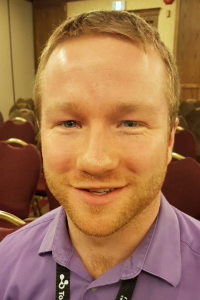People power is still the most important factor to consider in converting from gestation stalls to loose housing for sows, said all three speakers invited to address the details during the 2017 Banff Pork Seminar. Mark Fynn, manager of quality assurance and animal care programs for Manitoba Pork, veterinary professor Tom Parsons of the University of Pennsylvania and Kevin Stuckey, sow division manager for Cooper Farms in Ohio gave their observations on making the conversion during a breakout session at Banff Pork Seminar.
All three addressed the training and attitude of barn managers and staff as the central factor in setting up a smooth transition, regardless of the finer details including genetics, feeding systems, stall arrangements and flooring.
Monitoring sow behaviour and removing sows that are having or causing trouble is up to the people directly involved with them as is monitoring and managing the feeding system, said Fynn.
 “One of the biggest things about picking group housing systems is making sure that you have a buy-in from your managers and your personnel in the barn.
“One of the biggest things about picking group housing systems is making sure that you have a buy-in from your managers and your personnel in the barn.
“Those people that don’t buy into it, they think it’s going to fail. Well, I can tell you they’ll make sure it fails. Unfortunately, in some situations, you’re going to have to let some people go,” said Fynn.
“The more buy-in you can get from the staff that will be working the barn and the managers that will be working the barn, the better off and more successful the system is likely to be.”
Parsons followed up by stating that the role of people in making the transition has been largely unappreciated.
“People are the much harder issue to tackle, because you need to get that right every day in the barn,” said Parsons.
He was at the controls when U Penn started building a new barn in the late 1990s, going with loose housing and electronic sow feeding because that was becoming the trend and they wanted new students to be exposed to the systems they would see in the field.
Since then, he has helped several farms of various sizes make the conversion and has seen a spectrum of results.
“The physical plants on many of those farms are almost identical, so we asked that question: ‘Why are we getting those variable results?’”
Parsons said he arrived at the decision that the different people in the different barns were what had produced the variations.
“Any of us that work in the industry know that we can take good stockmen or good swine people and they’ll make any physical setting work. Alternatively, even the best designed barn cannot make that (happen) with inadequate staff.”
Human-animal interaction is more important in a pen-gestation barn than in a stall barn, said Parsons.
For example, it will be harder for barn staff to accomplish their tasks if the sows are unnecessarily fearful of them, he said. A sow in a stall can only go so far to escape vaccination. In a pen, however, a frightened sow is going to bolt. That, in turn, frustrates the worker, who is going to have less job satisfaction and it starts a downward spiral.
Stuckey also weighed in on the human factors in managing penned sows.
“It’s not about the system, it’s just about the people you get in there,” said Stuckey, who has multiple barns including two recent conversions in his care.
He argued against the “myth” that workers from stall barns cannot make the transition to pens and ESFs.
“We heard this a lot. So, we took that advice, and we selected two young men that worked in our system. Neither one had a lot of sow experience. Both had done very well in small roles, managing a boar stud with just a couple people, managing our gilt barns with just a couple people.
Both managers found themselves overwhelmed, not by the technology, but by issues among the people working with them. This experience was entirely different in a 2016 start-up, when Cooper Farms brought two highly experienced people in from their stall operation to manage loose-housing barns.
“They had control of the people, they had control of the fittings and they had time to learn the ESF.”
Stuckey determined from the differences in those two experiences that, for conversion to be successful, managers must have strong people skills. They must be organized, they should be willing to lead and delegate, they should have some problem-solving ability, basic maintenance skills, computer skills and experience in sow barns.
He said that, after a turnover of five different managers, the farm that had the problem now has “a real keeper who quickly learned the technology and had all the other skills necessary to keep the barn running smoothly.
He underscored the human factor, stating that pigs are generally easier to manage than people. •
— By Brenda Kossowan





